SingTel and StarHub: A Detailed Financial Analysis and WACC Report
VerifiedAdded on 2023/04/23
|17
|2725
|478
Report
AI Summary
This report provides a financial analysis of Singapore Telecommunications Limited (Singtel) and StarHub, focusing on the calculation and comparison of their Weighted Average Cost of Capital (WACC) over three years. It details the methodology used to calculate WACC, including the cost of equity ...
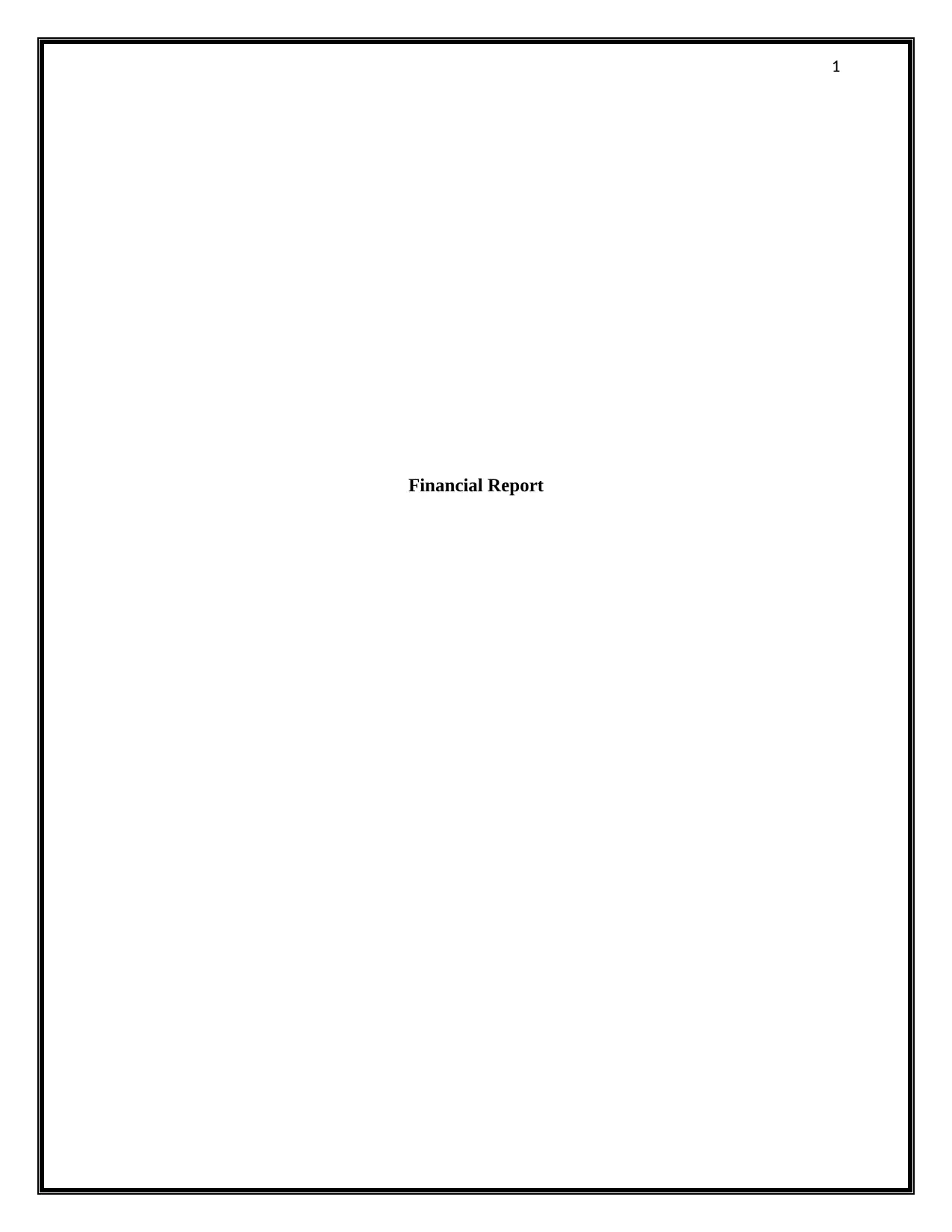
1
Financial Report
Financial Report
Paraphrase This Document
Need a fresh take? Get an instant paraphrase of this document with our AI Paraphraser
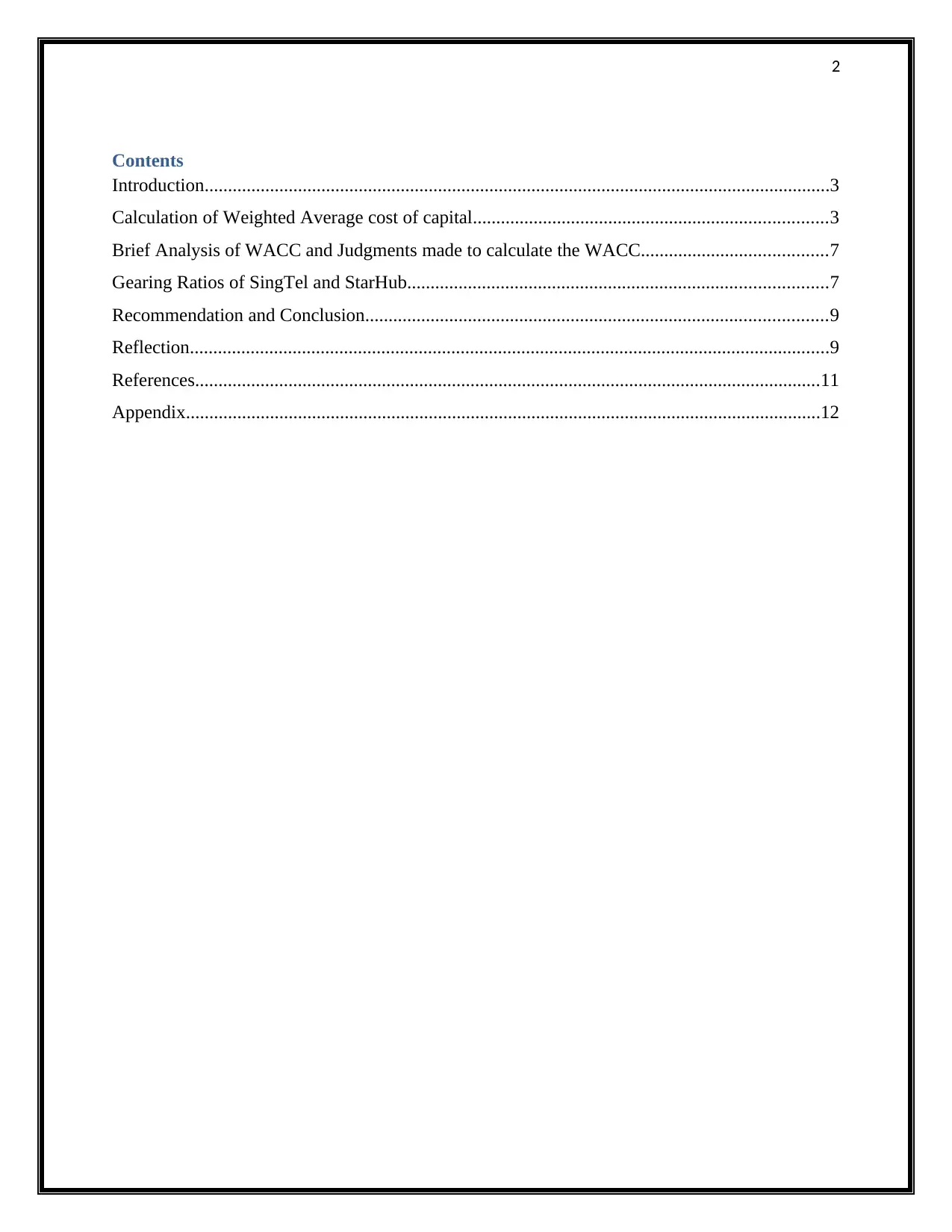
2
Contents
Introduction......................................................................................................................................3
Calculation of Weighted Average cost of capital............................................................................3
Brief Analysis of WACC and Judgments made to calculate the WACC........................................7
Gearing Ratios of SingTel and StarHub..........................................................................................7
Recommendation and Conclusion...................................................................................................9
Reflection.........................................................................................................................................9
References......................................................................................................................................11
Appendix........................................................................................................................................12
Contents
Introduction......................................................................................................................................3
Calculation of Weighted Average cost of capital............................................................................3
Brief Analysis of WACC and Judgments made to calculate the WACC........................................7
Gearing Ratios of SingTel and StarHub..........................................................................................7
Recommendation and Conclusion...................................................................................................9
Reflection.........................................................................................................................................9
References......................................................................................................................................11
Appendix........................................................................................................................................12
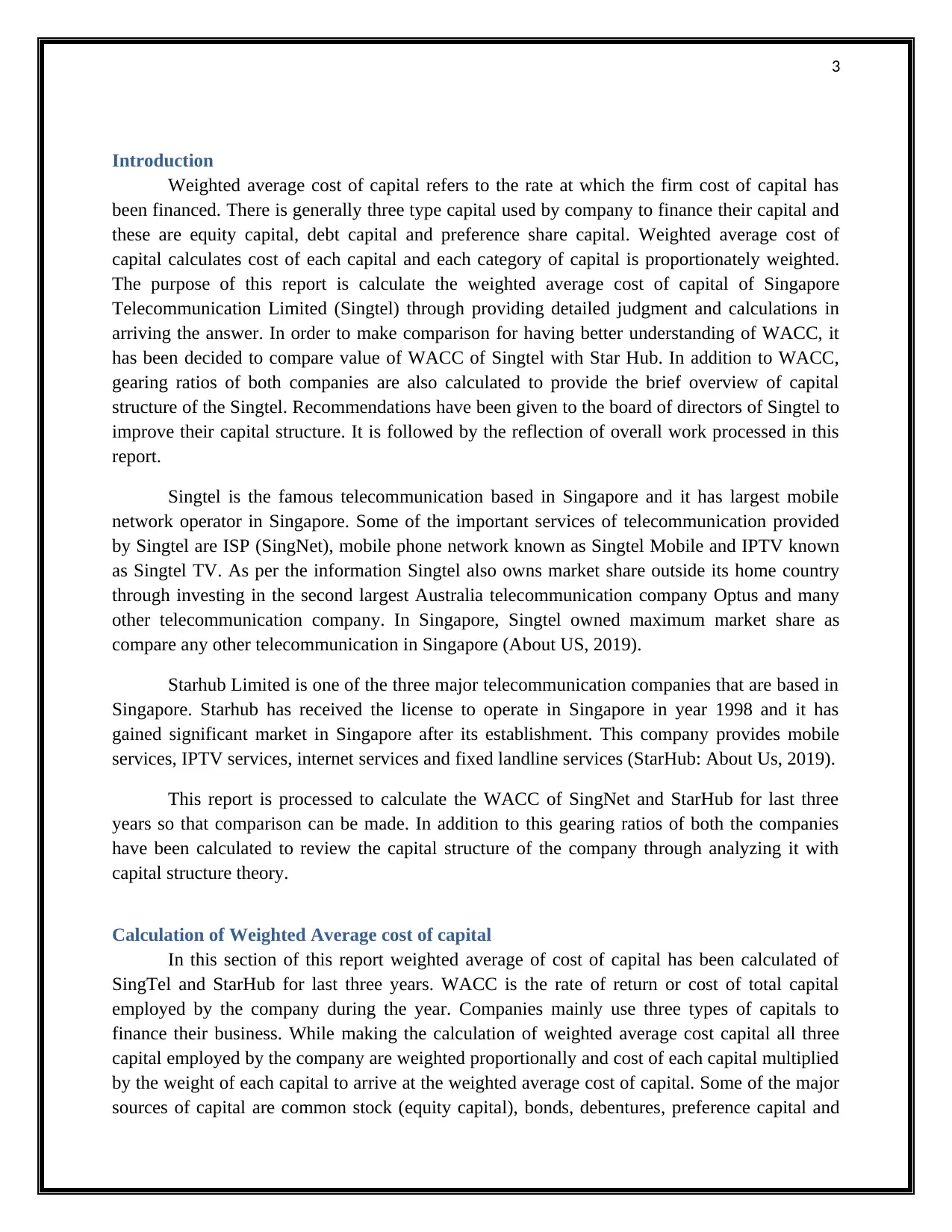
3
Introduction
Weighted average cost of capital refers to the rate at which the firm cost of capital has
been financed. There is generally three type capital used by company to finance their capital and
these are equity capital, debt capital and preference share capital. Weighted average cost of
capital calculates cost of each capital and each category of capital is proportionately weighted.
The purpose of this report is calculate the weighted average cost of capital of Singapore
Telecommunication Limited (Singtel) through providing detailed judgment and calculations in
arriving the answer. In order to make comparison for having better understanding of WACC, it
has been decided to compare value of WACC of Singtel with Star Hub. In addition to WACC,
gearing ratios of both companies are also calculated to provide the brief overview of capital
structure of the Singtel. Recommendations have been given to the board of directors of Singtel to
improve their capital structure. It is followed by the reflection of overall work processed in this
report.
Singtel is the famous telecommunication based in Singapore and it has largest mobile
network operator in Singapore. Some of the important services of telecommunication provided
by Singtel are ISP (SingNet), mobile phone network known as Singtel Mobile and IPTV known
as Singtel TV. As per the information Singtel also owns market share outside its home country
through investing in the second largest Australia telecommunication company Optus and many
other telecommunication company. In Singapore, Singtel owned maximum market share as
compare any other telecommunication in Singapore (About US, 2019).
Starhub Limited is one of the three major telecommunication companies that are based in
Singapore. Starhub has received the license to operate in Singapore in year 1998 and it has
gained significant market in Singapore after its establishment. This company provides mobile
services, IPTV services, internet services and fixed landline services (StarHub: About Us, 2019).
This report is processed to calculate the WACC of SingNet and StarHub for last three
years so that comparison can be made. In addition to this gearing ratios of both the companies
have been calculated to review the capital structure of the company through analyzing it with
capital structure theory.
Calculation of Weighted Average cost of capital
In this section of this report weighted average of cost of capital has been calculated of
SingTel and StarHub for last three years. WACC is the rate of return or cost of total capital
employed by the company during the year. Companies mainly use three types of capitals to
finance their business. While making the calculation of weighted average cost capital all three
capital employed by the company are weighted proportionally and cost of each capital multiplied
by the weight of each capital to arrive at the weighted average cost of capital. Some of the major
sources of capital are common stock (equity capital), bonds, debentures, preference capital and
Introduction
Weighted average cost of capital refers to the rate at which the firm cost of capital has
been financed. There is generally three type capital used by company to finance their capital and
these are equity capital, debt capital and preference share capital. Weighted average cost of
capital calculates cost of each capital and each category of capital is proportionately weighted.
The purpose of this report is calculate the weighted average cost of capital of Singapore
Telecommunication Limited (Singtel) through providing detailed judgment and calculations in
arriving the answer. In order to make comparison for having better understanding of WACC, it
has been decided to compare value of WACC of Singtel with Star Hub. In addition to WACC,
gearing ratios of both companies are also calculated to provide the brief overview of capital
structure of the Singtel. Recommendations have been given to the board of directors of Singtel to
improve their capital structure. It is followed by the reflection of overall work processed in this
report.
Singtel is the famous telecommunication based in Singapore and it has largest mobile
network operator in Singapore. Some of the important services of telecommunication provided
by Singtel are ISP (SingNet), mobile phone network known as Singtel Mobile and IPTV known
as Singtel TV. As per the information Singtel also owns market share outside its home country
through investing in the second largest Australia telecommunication company Optus and many
other telecommunication company. In Singapore, Singtel owned maximum market share as
compare any other telecommunication in Singapore (About US, 2019).
Starhub Limited is one of the three major telecommunication companies that are based in
Singapore. Starhub has received the license to operate in Singapore in year 1998 and it has
gained significant market in Singapore after its establishment. This company provides mobile
services, IPTV services, internet services and fixed landline services (StarHub: About Us, 2019).
This report is processed to calculate the WACC of SingNet and StarHub for last three
years so that comparison can be made. In addition to this gearing ratios of both the companies
have been calculated to review the capital structure of the company through analyzing it with
capital structure theory.
Calculation of Weighted Average cost of capital
In this section of this report weighted average of cost of capital has been calculated of
SingTel and StarHub for last three years. WACC is the rate of return or cost of total capital
employed by the company during the year. Companies mainly use three types of capitals to
finance their business. While making the calculation of weighted average cost capital all three
capital employed by the company are weighted proportionally and cost of each capital multiplied
by the weight of each capital to arrive at the weighted average cost of capital. Some of the major
sources of capital are common stock (equity capital), bonds, debentures, preference capital and
⊘ This is a preview!⊘
Do you want full access?
Subscribe today to unlock all pages.

Trusted by 1+ million students worldwide
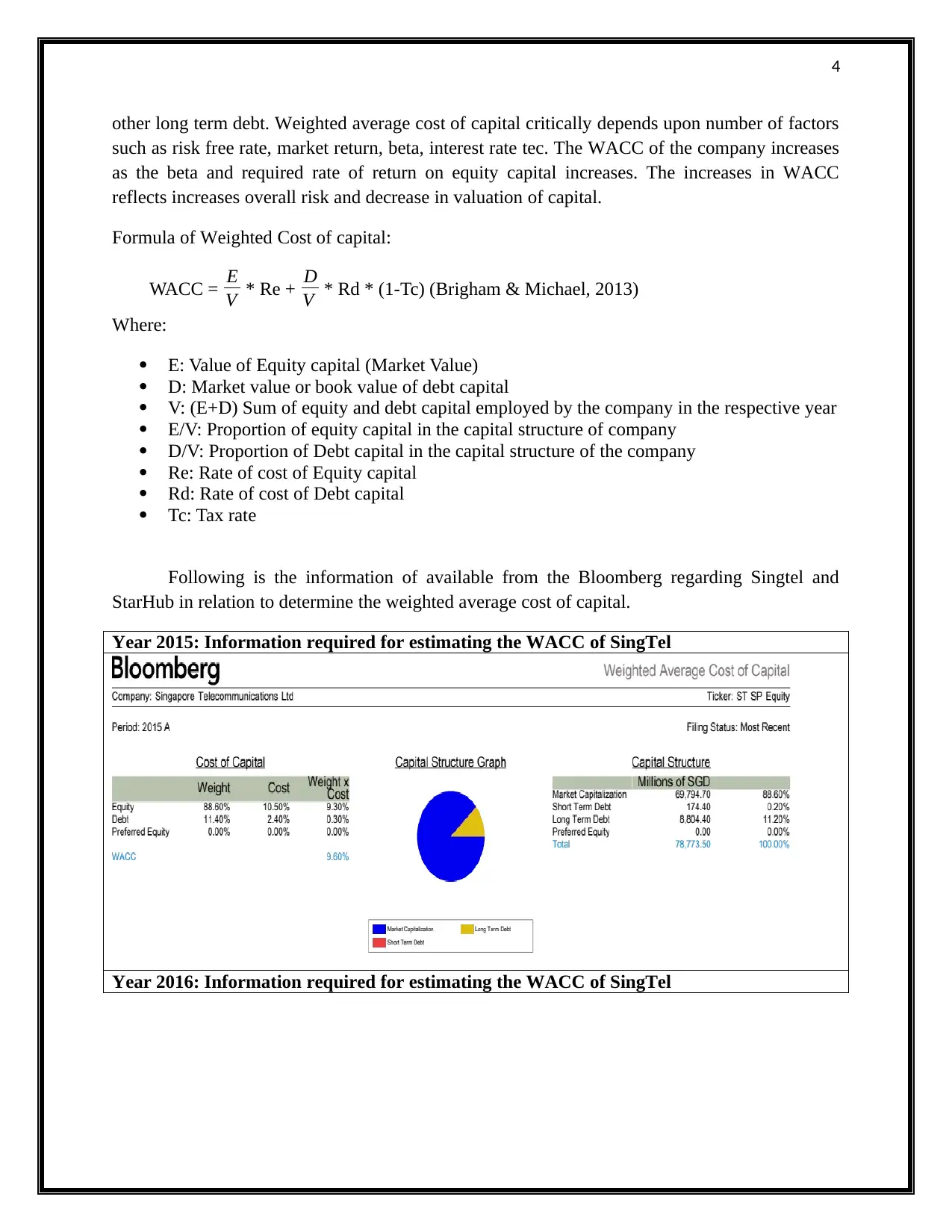
4
other long term debt. Weighted average cost of capital critically depends upon number of factors
such as risk free rate, market return, beta, interest rate tec. The WACC of the company increases
as the beta and required rate of return on equity capital increases. The increases in WACC
reflects increases overall risk and decrease in valuation of capital.
Formula of Weighted Cost of capital:
WACC = E
V * Re + D
V * Rd * (1-Tc) (Brigham & Michael, 2013)
Where:
E: Value of Equity capital (Market Value)
D: Market value or book value of debt capital
V: (E+D) Sum of equity and debt capital employed by the company in the respective year
E/V: Proportion of equity capital in the capital structure of company
D/V: Proportion of Debt capital in the capital structure of the company
Re: Rate of cost of Equity capital
Rd: Rate of cost of Debt capital
Tc: Tax rate
Following is the information of available from the Bloomberg regarding Singtel and
StarHub in relation to determine the weighted average cost of capital.
Year 2015: Information required for estimating the WACC of SingTel
Year 2016: Information required for estimating the WACC of SingTel
other long term debt. Weighted average cost of capital critically depends upon number of factors
such as risk free rate, market return, beta, interest rate tec. The WACC of the company increases
as the beta and required rate of return on equity capital increases. The increases in WACC
reflects increases overall risk and decrease in valuation of capital.
Formula of Weighted Cost of capital:
WACC = E
V * Re + D
V * Rd * (1-Tc) (Brigham & Michael, 2013)
Where:
E: Value of Equity capital (Market Value)
D: Market value or book value of debt capital
V: (E+D) Sum of equity and debt capital employed by the company in the respective year
E/V: Proportion of equity capital in the capital structure of company
D/V: Proportion of Debt capital in the capital structure of the company
Re: Rate of cost of Equity capital
Rd: Rate of cost of Debt capital
Tc: Tax rate
Following is the information of available from the Bloomberg regarding Singtel and
StarHub in relation to determine the weighted average cost of capital.
Year 2015: Information required for estimating the WACC of SingTel
Year 2016: Information required for estimating the WACC of SingTel
Paraphrase This Document
Need a fresh take? Get an instant paraphrase of this document with our AI Paraphraser
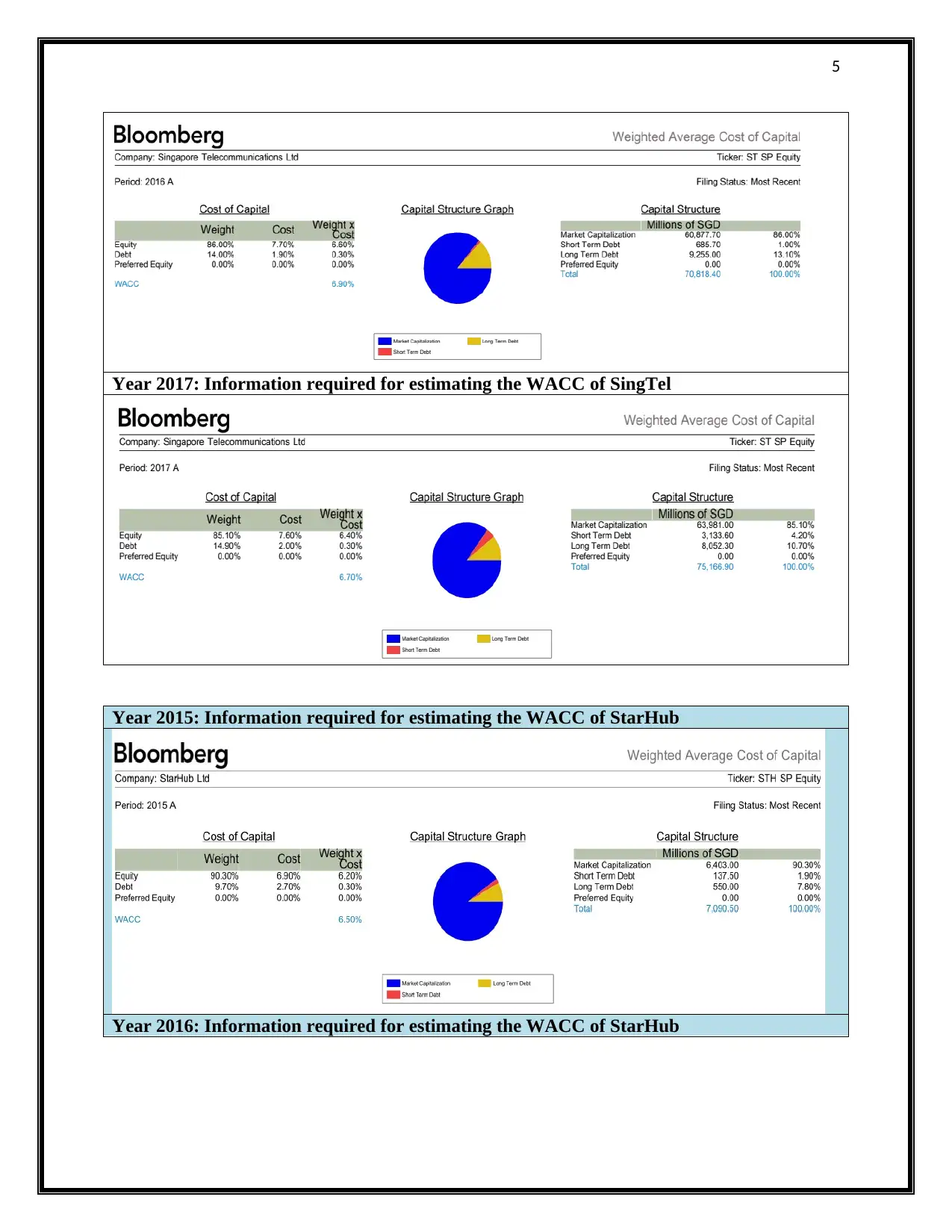
5
Year 2017: Information required for estimating the WACC of SingTel
Year 2015: Information required for estimating the WACC of StarHub
Year 2016: Information required for estimating the WACC of StarHub
Year 2017: Information required for estimating the WACC of SingTel
Year 2015: Information required for estimating the WACC of StarHub
Year 2016: Information required for estimating the WACC of StarHub
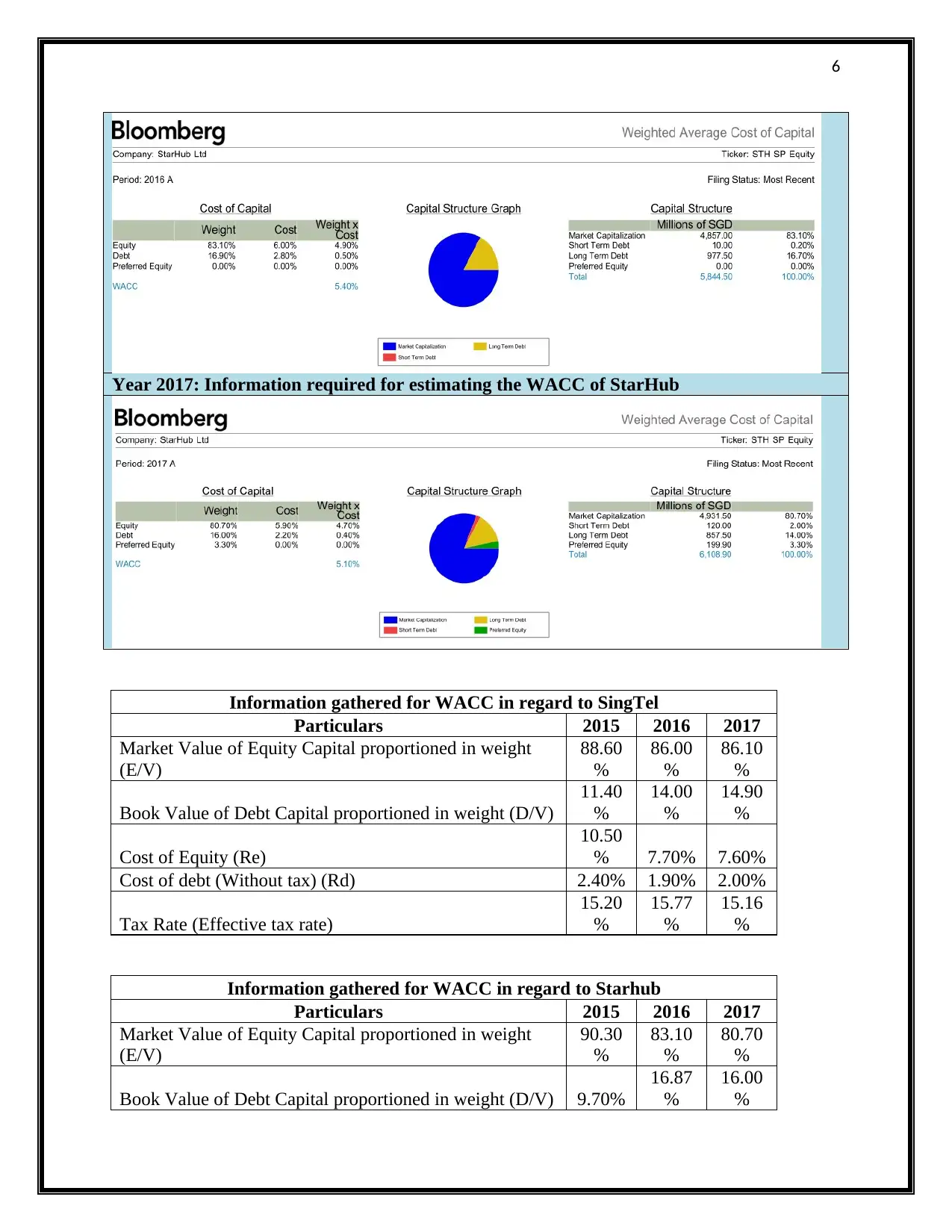
6
Year 2017: Information required for estimating the WACC of StarHub
Information gathered for WACC in regard to SingTel
Particulars 2015 2016 2017
Market Value of Equity Capital proportioned in weight
(E/V)
88.60
%
86.00
%
86.10
%
Book Value of Debt Capital proportioned in weight (D/V)
11.40
%
14.00
%
14.90
%
Cost of Equity (Re)
10.50
% 7.70% 7.60%
Cost of debt (Without tax) (Rd) 2.40% 1.90% 2.00%
Tax Rate (Effective tax rate)
15.20
%
15.77
%
15.16
%
Information gathered for WACC in regard to Starhub
Particulars 2015 2016 2017
Market Value of Equity Capital proportioned in weight
(E/V)
90.30
%
83.10
%
80.70
%
Book Value of Debt Capital proportioned in weight (D/V) 9.70%
16.87
%
16.00
%
Year 2017: Information required for estimating the WACC of StarHub
Information gathered for WACC in regard to SingTel
Particulars 2015 2016 2017
Market Value of Equity Capital proportioned in weight
(E/V)
88.60
%
86.00
%
86.10
%
Book Value of Debt Capital proportioned in weight (D/V)
11.40
%
14.00
%
14.90
%
Cost of Equity (Re)
10.50
% 7.70% 7.60%
Cost of debt (Without tax) (Rd) 2.40% 1.90% 2.00%
Tax Rate (Effective tax rate)
15.20
%
15.77
%
15.16
%
Information gathered for WACC in regard to Starhub
Particulars 2015 2016 2017
Market Value of Equity Capital proportioned in weight
(E/V)
90.30
%
83.10
%
80.70
%
Book Value of Debt Capital proportioned in weight (D/V) 9.70%
16.87
%
16.00
%
⊘ This is a preview!⊘
Do you want full access?
Subscribe today to unlock all pages.

Trusted by 1+ million students worldwide
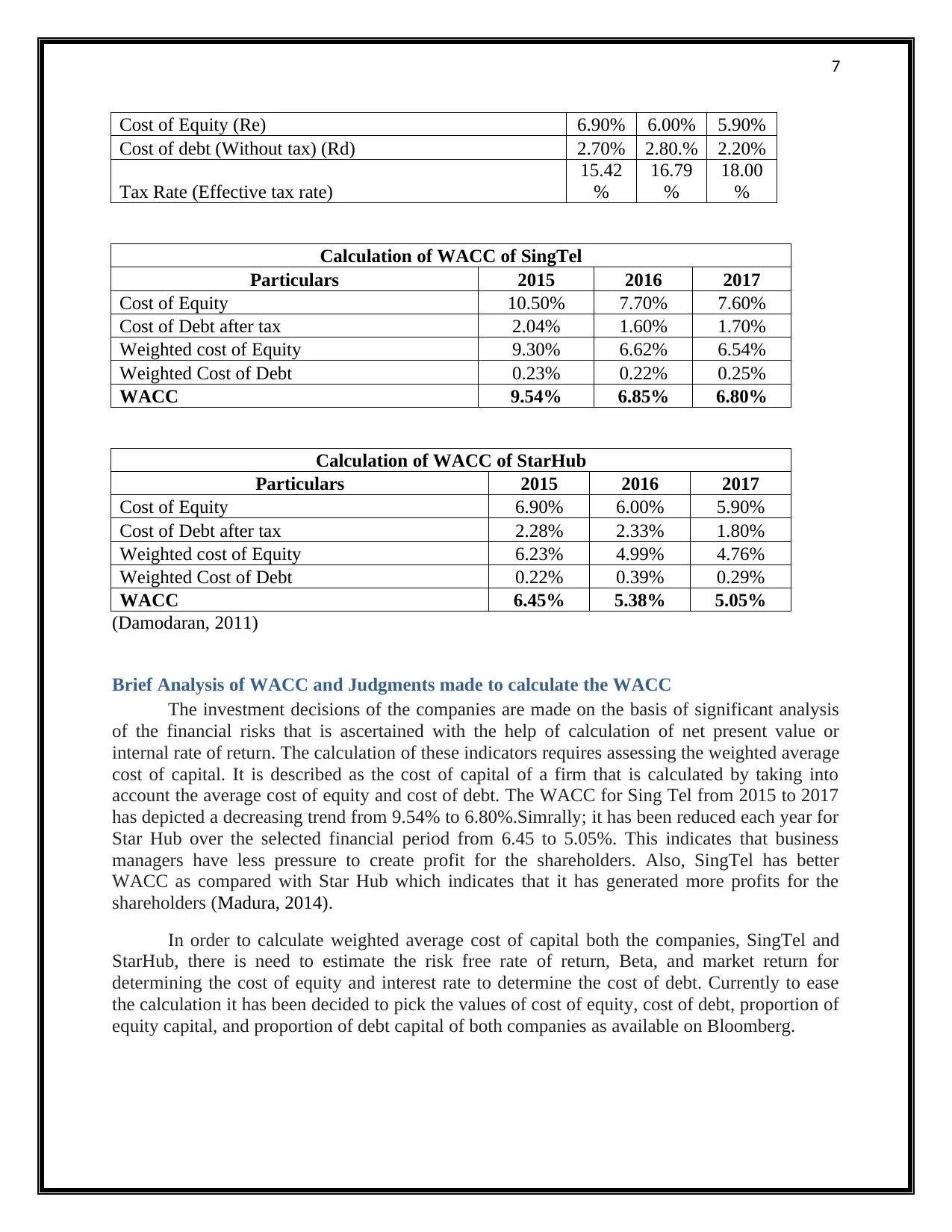
7
Cost of Equity (Re) 6.90% 6.00% 5.90%
Cost of debt (Without tax) (Rd) 2.70% 2.80.% 2.20%
Tax Rate (Effective tax rate)
15.42
%
16.79
%
18.00
%
Calculation of WACC of SingTel
Particulars 2015 2016 2017
Cost of Equity 10.50% 7.70% 7.60%
Cost of Debt after tax 2.04% 1.60% 1.70%
Weighted cost of Equity 9.30% 6.62% 6.54%
Weighted Cost of Debt 0.23% 0.22% 0.25%
WACC 9.54% 6.85% 6.80%
Calculation of WACC of StarHub
Particulars 2015 2016 2017
Cost of Equity 6.90% 6.00% 5.90%
Cost of Debt after tax 2.28% 2.33% 1.80%
Weighted cost of Equity 6.23% 4.99% 4.76%
Weighted Cost of Debt 0.22% 0.39% 0.29%
WACC 6.45% 5.38% 5.05%
(Damodaran, 2011)
Brief Analysis of WACC and Judgments made to calculate the WACC
The investment decisions of the companies are made on the basis of significant analysis
of the financial risks that is ascertained with the help of calculation of net present value or
internal rate of return. The calculation of these indicators requires assessing the weighted average
cost of capital. It is described as the cost of capital of a firm that is calculated by taking into
account the average cost of equity and cost of debt. The WACC for Sing Tel from 2015 to 2017
has depicted a decreasing trend from 9.54% to 6.80%.Simrally; it has been reduced each year for
Star Hub over the selected financial period from 6.45 to 5.05%. This indicates that business
managers have less pressure to create profit for the shareholders. Also, SingTel has better
WACC as compared with Star Hub which indicates that it has generated more profits for the
shareholders (Madura, 2014).
In order to calculate weighted average cost of capital both the companies, SingTel and
StarHub, there is need to estimate the risk free rate of return, Beta, and market return for
determining the cost of equity and interest rate to determine the cost of debt. Currently to ease
the calculation it has been decided to pick the values of cost of equity, cost of debt, proportion of
equity capital, and proportion of debt capital of both companies as available on Bloomberg.
Cost of Equity (Re) 6.90% 6.00% 5.90%
Cost of debt (Without tax) (Rd) 2.70% 2.80.% 2.20%
Tax Rate (Effective tax rate)
15.42
%
16.79
%
18.00
%
Calculation of WACC of SingTel
Particulars 2015 2016 2017
Cost of Equity 10.50% 7.70% 7.60%
Cost of Debt after tax 2.04% 1.60% 1.70%
Weighted cost of Equity 9.30% 6.62% 6.54%
Weighted Cost of Debt 0.23% 0.22% 0.25%
WACC 9.54% 6.85% 6.80%
Calculation of WACC of StarHub
Particulars 2015 2016 2017
Cost of Equity 6.90% 6.00% 5.90%
Cost of Debt after tax 2.28% 2.33% 1.80%
Weighted cost of Equity 6.23% 4.99% 4.76%
Weighted Cost of Debt 0.22% 0.39% 0.29%
WACC 6.45% 5.38% 5.05%
(Damodaran, 2011)
Brief Analysis of WACC and Judgments made to calculate the WACC
The investment decisions of the companies are made on the basis of significant analysis
of the financial risks that is ascertained with the help of calculation of net present value or
internal rate of return. The calculation of these indicators requires assessing the weighted average
cost of capital. It is described as the cost of capital of a firm that is calculated by taking into
account the average cost of equity and cost of debt. The WACC for Sing Tel from 2015 to 2017
has depicted a decreasing trend from 9.54% to 6.80%.Simrally; it has been reduced each year for
Star Hub over the selected financial period from 6.45 to 5.05%. This indicates that business
managers have less pressure to create profit for the shareholders. Also, SingTel has better
WACC as compared with Star Hub which indicates that it has generated more profits for the
shareholders (Madura, 2014).
In order to calculate weighted average cost of capital both the companies, SingTel and
StarHub, there is need to estimate the risk free rate of return, Beta, and market return for
determining the cost of equity and interest rate to determine the cost of debt. Currently to ease
the calculation it has been decided to pick the values of cost of equity, cost of debt, proportion of
equity capital, and proportion of debt capital of both companies as available on Bloomberg.
Paraphrase This Document
Need a fresh take? Get an instant paraphrase of this document with our AI Paraphraser
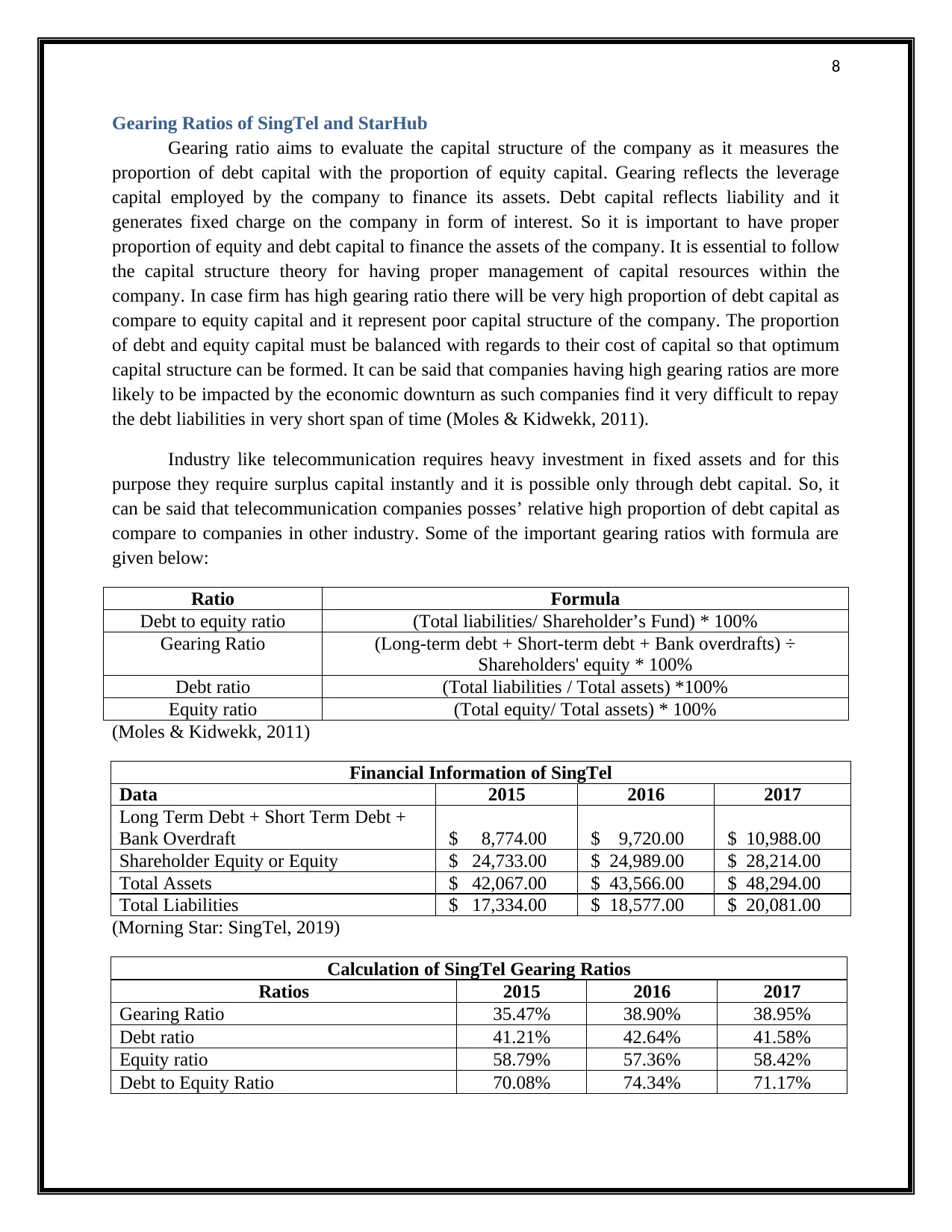
8
Gearing Ratios of SingTel and StarHub
Gearing ratio aims to evaluate the capital structure of the company as it measures the
proportion of debt capital with the proportion of equity capital. Gearing reflects the leverage
capital employed by the company to finance its assets. Debt capital reflects liability and it
generates fixed charge on the company in form of interest. So it is important to have proper
proportion of equity and debt capital to finance the assets of the company. It is essential to follow
the capital structure theory for having proper management of capital resources within the
company. In case firm has high gearing ratio there will be very high proportion of debt capital as
compare to equity capital and it represent poor capital structure of the company. The proportion
of debt and equity capital must be balanced with regards to their cost of capital so that optimum
capital structure can be formed. It can be said that companies having high gearing ratios are more
likely to be impacted by the economic downturn as such companies find it very difficult to repay
the debt liabilities in very short span of time (Moles & Kidwekk, 2011).
Industry like telecommunication requires heavy investment in fixed assets and for this
purpose they require surplus capital instantly and it is possible only through debt capital. So, it
can be said that telecommunication companies posses’ relative high proportion of debt capital as
compare to companies in other industry. Some of the important gearing ratios with formula are
given below:
Ratio Formula
Debt to equity ratio (Total liabilities/ Shareholder’s Fund) * 100%
Gearing Ratio (Long-term debt + Short-term debt + Bank overdrafts) ÷
Shareholders' equity * 100%
Debt ratio (Total liabilities / Total assets) *100%
Equity ratio (Total equity/ Total assets) * 100%
(Moles & Kidwekk, 2011)
Financial Information of SingTel
Data 2015 2016 2017
Long Term Debt + Short Term Debt +
Bank Overdraft $ 8,774.00 $ 9,720.00 $ 10,988.00
Shareholder Equity or Equity $ 24,733.00 $ 24,989.00 $ 28,214.00
Total Assets $ 42,067.00 $ 43,566.00 $ 48,294.00
Total Liabilities $ 17,334.00 $ 18,577.00 $ 20,081.00
(Morning Star: SingTel, 2019)
Calculation of SingTel Gearing Ratios
Ratios 2015 2016 2017
Gearing Ratio 35.47% 38.90% 38.95%
Debt ratio 41.21% 42.64% 41.58%
Equity ratio 58.79% 57.36% 58.42%
Debt to Equity Ratio 70.08% 74.34% 71.17%
Gearing Ratios of SingTel and StarHub
Gearing ratio aims to evaluate the capital structure of the company as it measures the
proportion of debt capital with the proportion of equity capital. Gearing reflects the leverage
capital employed by the company to finance its assets. Debt capital reflects liability and it
generates fixed charge on the company in form of interest. So it is important to have proper
proportion of equity and debt capital to finance the assets of the company. It is essential to follow
the capital structure theory for having proper management of capital resources within the
company. In case firm has high gearing ratio there will be very high proportion of debt capital as
compare to equity capital and it represent poor capital structure of the company. The proportion
of debt and equity capital must be balanced with regards to their cost of capital so that optimum
capital structure can be formed. It can be said that companies having high gearing ratios are more
likely to be impacted by the economic downturn as such companies find it very difficult to repay
the debt liabilities in very short span of time (Moles & Kidwekk, 2011).
Industry like telecommunication requires heavy investment in fixed assets and for this
purpose they require surplus capital instantly and it is possible only through debt capital. So, it
can be said that telecommunication companies posses’ relative high proportion of debt capital as
compare to companies in other industry. Some of the important gearing ratios with formula are
given below:
Ratio Formula
Debt to equity ratio (Total liabilities/ Shareholder’s Fund) * 100%
Gearing Ratio (Long-term debt + Short-term debt + Bank overdrafts) ÷
Shareholders' equity * 100%
Debt ratio (Total liabilities / Total assets) *100%
Equity ratio (Total equity/ Total assets) * 100%
(Moles & Kidwekk, 2011)
Financial Information of SingTel
Data 2015 2016 2017
Long Term Debt + Short Term Debt +
Bank Overdraft $ 8,774.00 $ 9,720.00 $ 10,988.00
Shareholder Equity or Equity $ 24,733.00 $ 24,989.00 $ 28,214.00
Total Assets $ 42,067.00 $ 43,566.00 $ 48,294.00
Total Liabilities $ 17,334.00 $ 18,577.00 $ 20,081.00
(Morning Star: SingTel, 2019)
Calculation of SingTel Gearing Ratios
Ratios 2015 2016 2017
Gearing Ratio 35.47% 38.90% 38.95%
Debt ratio 41.21% 42.64% 41.58%
Equity ratio 58.79% 57.36% 58.42%
Debt to Equity Ratio 70.08% 74.34% 71.17%

9
Financial Information of StarHub
Data 2015 2016 2017
Long Term Debt + Short Term Debt +
Bank Overdraft $ 688.00 $ 988.00 $ 978.00
Shareholder Equity or Equity $ 188.00 $ 195.00 $ 341.00
Total Assets $ 1,909.00 $ 2,196.00 $ 2,352.00
Total Liabilities $ 1,722.00 $ 2,001.00 $ 2,012.00
(Morning Star: StarHub, 2019)
Calculation of StarHub Gearing Ratios
Ratios 2015 2016 2017
Gearing Ratio 365.96% 506.67% 286.80%
Debt ratio 90.20% 91.12% 85.54%
Equity ratio 9.85% 8.88% 14.50%
Debt to Equity Ratio 915.96% 1026.15% 590.03%
Recommendation and Conclusion
In this section recommendation are given to board of directors of Singtel to improve their
capital structure. In the last two years it has been seen that management has increased the
percentage of debt capital as compare to year 2015. However, leverage ratio was above 70%
during the last three years that clearly reflects significant proportion of debt capital has been used
to finance the assets of the company. Overall capital structure of SingTel was well organized
through looking at the debt ratio of last three years. The calculation of WACC clearly reflects
major improvement in average cost of capital as WACC was 9.54% in year 2015 and it was
reduced to 6.80% in year 2017 (Moles & Kidwekk, 2011).
Looking at the WACC and gearing ratios of SingTel it was recommended to the board of
SingTel to make a fresh issue of equity shares so that proportion of equity capital can be
increased and it will generate enough capital to expand the business. Looking the profitability
position of SingTel, shareholders will happily invest in the new issue of equity shares. It is also
recommended to the board to consider the debt capital as cost of debt is significantly low as
compare to cost of equity but in no case debt ratio must increase 50%.
Reflection
Weights of both the capital: While making the calculation of WACC of both companies
market value of equity capital has been consider as cost of equity critically dependent on
market values and it is important to consider market value of equity as it helps in
obtaining accurate WACC of both the companies. As debt capital is not traded on market
it is not feasible to consider the market value of debt capital, hence book value has been
consider for making the calculation.
Published Beta: The CAPM theory has defined ‘Beta’ as a means of assessing the
Financial Information of StarHub
Data 2015 2016 2017
Long Term Debt + Short Term Debt +
Bank Overdraft $ 688.00 $ 988.00 $ 978.00
Shareholder Equity or Equity $ 188.00 $ 195.00 $ 341.00
Total Assets $ 1,909.00 $ 2,196.00 $ 2,352.00
Total Liabilities $ 1,722.00 $ 2,001.00 $ 2,012.00
(Morning Star: StarHub, 2019)
Calculation of StarHub Gearing Ratios
Ratios 2015 2016 2017
Gearing Ratio 365.96% 506.67% 286.80%
Debt ratio 90.20% 91.12% 85.54%
Equity ratio 9.85% 8.88% 14.50%
Debt to Equity Ratio 915.96% 1026.15% 590.03%
Recommendation and Conclusion
In this section recommendation are given to board of directors of Singtel to improve their
capital structure. In the last two years it has been seen that management has increased the
percentage of debt capital as compare to year 2015. However, leverage ratio was above 70%
during the last three years that clearly reflects significant proportion of debt capital has been used
to finance the assets of the company. Overall capital structure of SingTel was well organized
through looking at the debt ratio of last three years. The calculation of WACC clearly reflects
major improvement in average cost of capital as WACC was 9.54% in year 2015 and it was
reduced to 6.80% in year 2017 (Moles & Kidwekk, 2011).
Looking at the WACC and gearing ratios of SingTel it was recommended to the board of
SingTel to make a fresh issue of equity shares so that proportion of equity capital can be
increased and it will generate enough capital to expand the business. Looking the profitability
position of SingTel, shareholders will happily invest in the new issue of equity shares. It is also
recommended to the board to consider the debt capital as cost of debt is significantly low as
compare to cost of equity but in no case debt ratio must increase 50%.
Reflection
Weights of both the capital: While making the calculation of WACC of both companies
market value of equity capital has been consider as cost of equity critically dependent on
market values and it is important to consider market value of equity as it helps in
obtaining accurate WACC of both the companies. As debt capital is not traded on market
it is not feasible to consider the market value of debt capital, hence book value has been
consider for making the calculation.
Published Beta: The CAPM theory has defined ‘Beta’ as a means of assessing the
⊘ This is a preview!⊘
Do you want full access?
Subscribe today to unlock all pages.

Trusted by 1+ million students worldwide
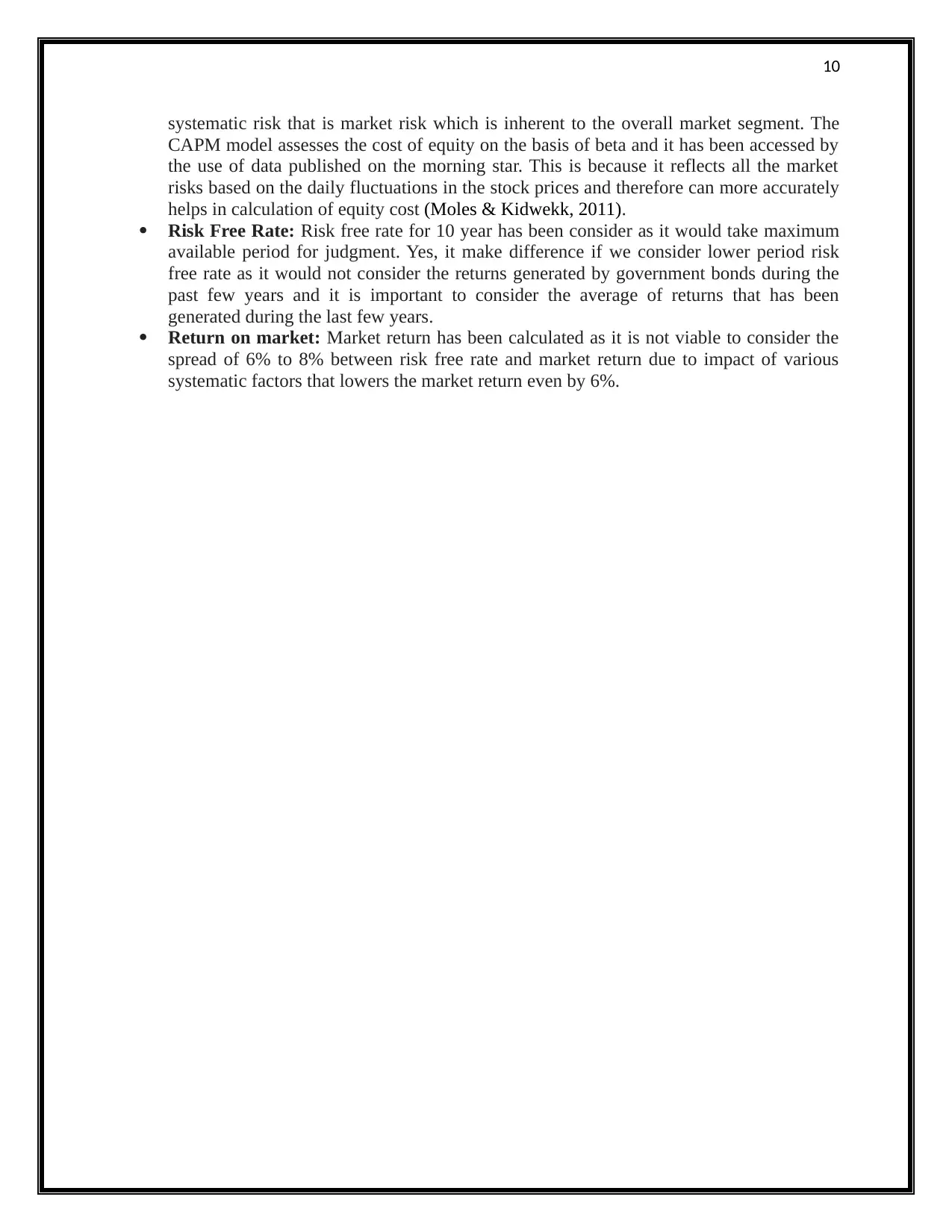
10
systematic risk that is market risk which is inherent to the overall market segment. The
CAPM model assesses the cost of equity on the basis of beta and it has been accessed by
the use of data published on the morning star. This is because it reflects all the market
risks based on the daily fluctuations in the stock prices and therefore can more accurately
helps in calculation of equity cost (Moles & Kidwekk, 2011).
Risk Free Rate: Risk free rate for 10 year has been consider as it would take maximum
available period for judgment. Yes, it make difference if we consider lower period risk
free rate as it would not consider the returns generated by government bonds during the
past few years and it is important to consider the average of returns that has been
generated during the last few years.
Return on market: Market return has been calculated as it is not viable to consider the
spread of 6% to 8% between risk free rate and market return due to impact of various
systematic factors that lowers the market return even by 6%.
systematic risk that is market risk which is inherent to the overall market segment. The
CAPM model assesses the cost of equity on the basis of beta and it has been accessed by
the use of data published on the morning star. This is because it reflects all the market
risks based on the daily fluctuations in the stock prices and therefore can more accurately
helps in calculation of equity cost (Moles & Kidwekk, 2011).
Risk Free Rate: Risk free rate for 10 year has been consider as it would take maximum
available period for judgment. Yes, it make difference if we consider lower period risk
free rate as it would not consider the returns generated by government bonds during the
past few years and it is important to consider the average of returns that has been
generated during the last few years.
Return on market: Market return has been calculated as it is not viable to consider the
spread of 6% to 8% between risk free rate and market return due to impact of various
systematic factors that lowers the market return even by 6%.
Paraphrase This Document
Need a fresh take? Get an instant paraphrase of this document with our AI Paraphraser
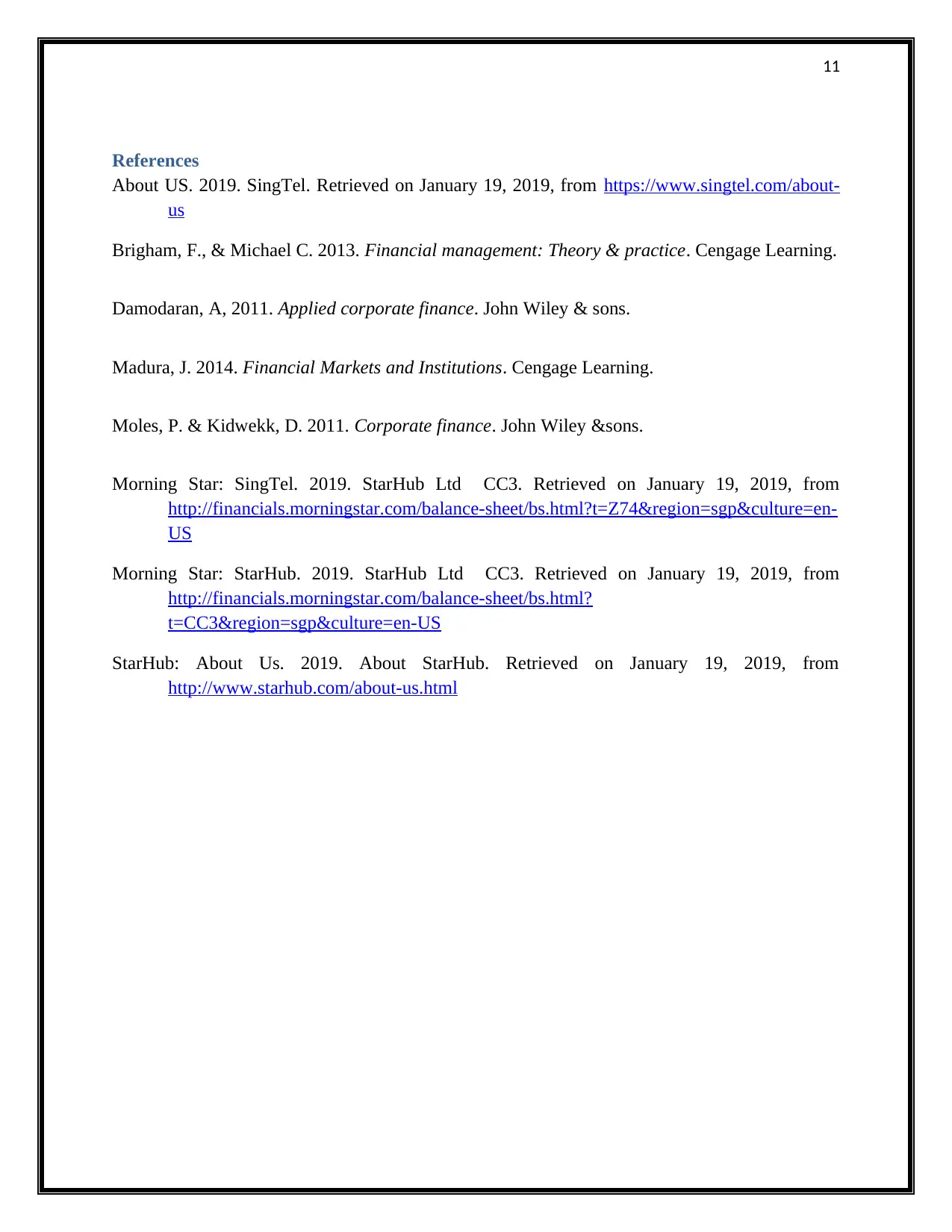
11
References
About US. 2019. SingTel. Retrieved on January 19, 2019, from https://www.singtel.com/about-
us
Brigham, F., & Michael C. 2013. Financial management: Theory & practice. Cengage Learning.
Damodaran, A, 2011. Applied corporate finance. John Wiley & sons.
Madura, J. 2014. Financial Markets and Institutions. Cengage Learning.
Moles, P. & Kidwekk, D. 2011. Corporate finance. John Wiley &sons.
Morning Star: SingTel. 2019. StarHub Ltd CC3. Retrieved on January 19, 2019, from
http://financials.morningstar.com/balance-sheet/bs.html?t=Z74®ion=sgp&culture=en-
US
Morning Star: StarHub. 2019. StarHub Ltd CC3. Retrieved on January 19, 2019, from
http://financials.morningstar.com/balance-sheet/bs.html?
t=CC3®ion=sgp&culture=en-US
StarHub: About Us. 2019. About StarHub. Retrieved on January 19, 2019, from
http://www.starhub.com/about-us.html
References
About US. 2019. SingTel. Retrieved on January 19, 2019, from https://www.singtel.com/about-
us
Brigham, F., & Michael C. 2013. Financial management: Theory & practice. Cengage Learning.
Damodaran, A, 2011. Applied corporate finance. John Wiley & sons.
Madura, J. 2014. Financial Markets and Institutions. Cengage Learning.
Moles, P. & Kidwekk, D. 2011. Corporate finance. John Wiley &sons.
Morning Star: SingTel. 2019. StarHub Ltd CC3. Retrieved on January 19, 2019, from
http://financials.morningstar.com/balance-sheet/bs.html?t=Z74®ion=sgp&culture=en-
US
Morning Star: StarHub. 2019. StarHub Ltd CC3. Retrieved on January 19, 2019, from
http://financials.morningstar.com/balance-sheet/bs.html?
t=CC3®ion=sgp&culture=en-US
StarHub: About Us. 2019. About StarHub. Retrieved on January 19, 2019, from
http://www.starhub.com/about-us.html
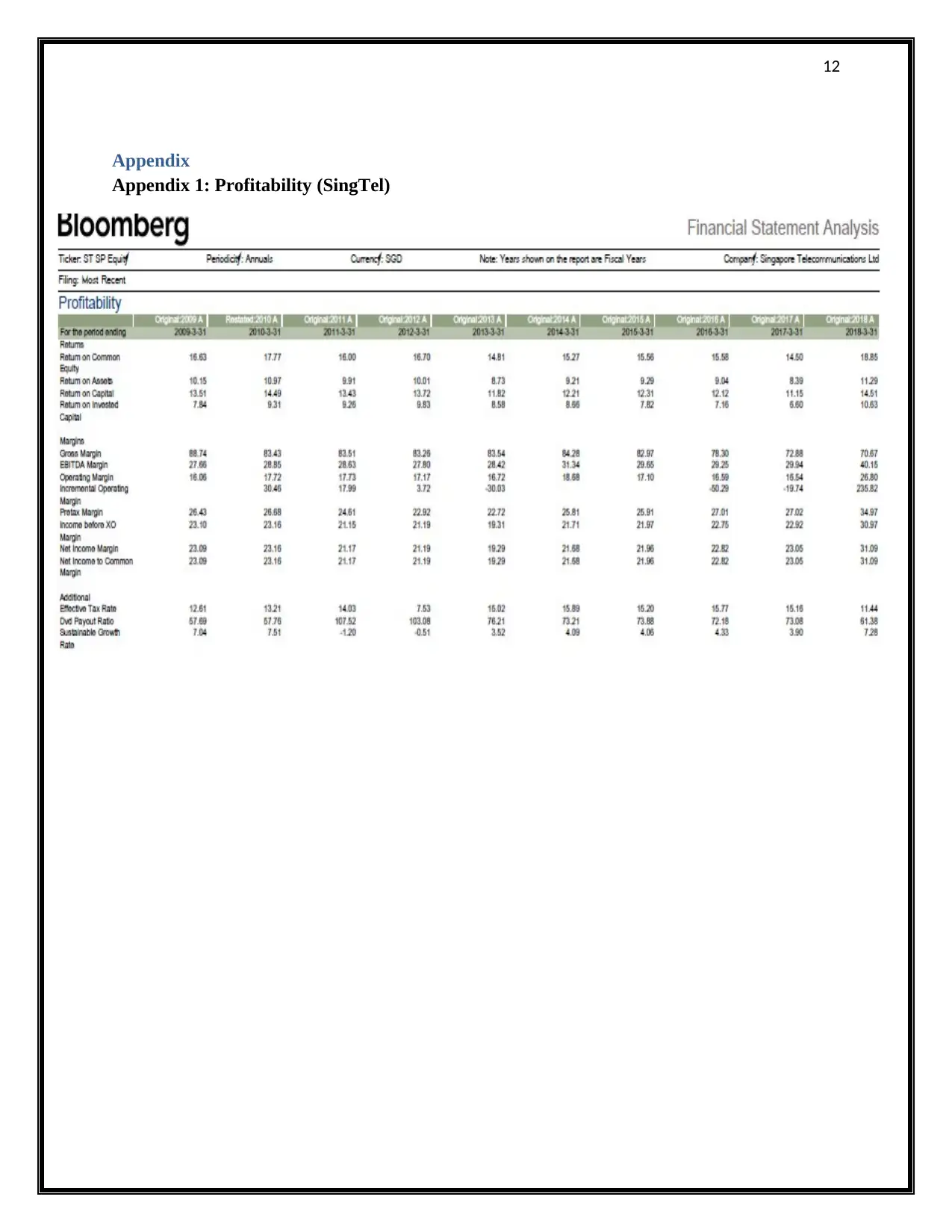
12
Appendix
Appendix 1: Profitability (SingTel)
Appendix
Appendix 1: Profitability (SingTel)
⊘ This is a preview!⊘
Do you want full access?
Subscribe today to unlock all pages.

Trusted by 1+ million students worldwide
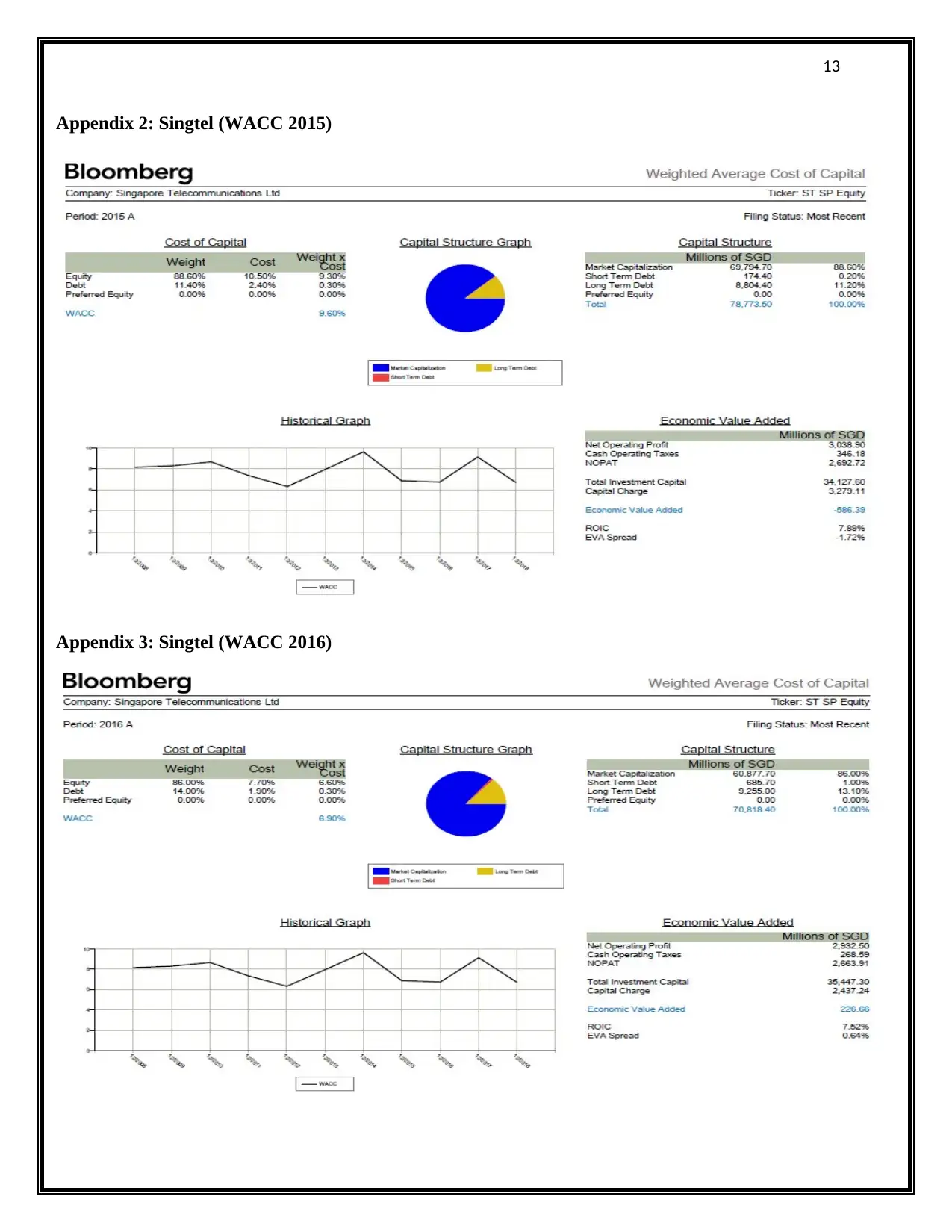
13
Appendix 2: Singtel (WACC 2015)
Appendix 3: Singtel (WACC 2016)
Appendix 2: Singtel (WACC 2015)
Appendix 3: Singtel (WACC 2016)
Paraphrase This Document
Need a fresh take? Get an instant paraphrase of this document with our AI Paraphraser
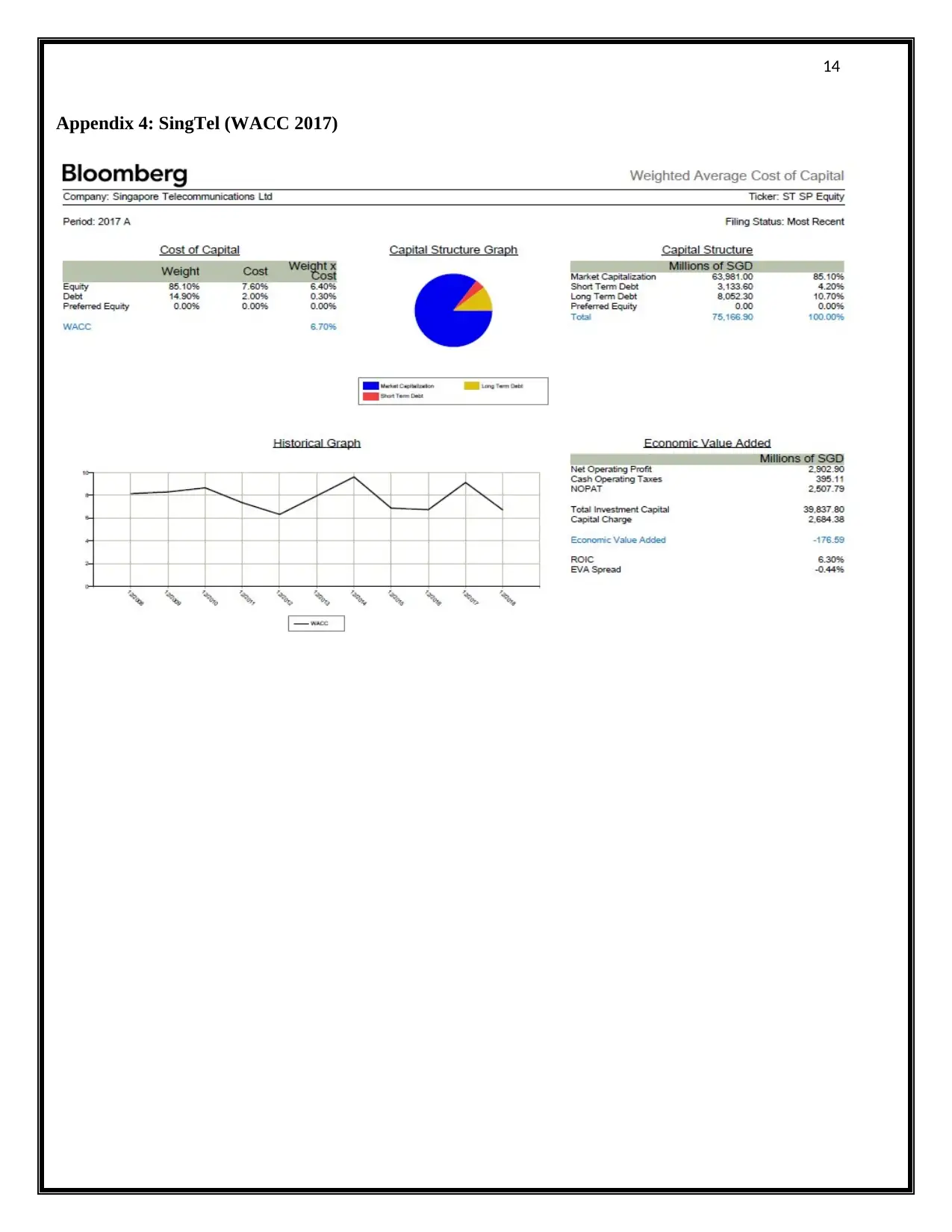
14
Appendix 4: SingTel (WACC 2017)
Appendix 4: SingTel (WACC 2017)
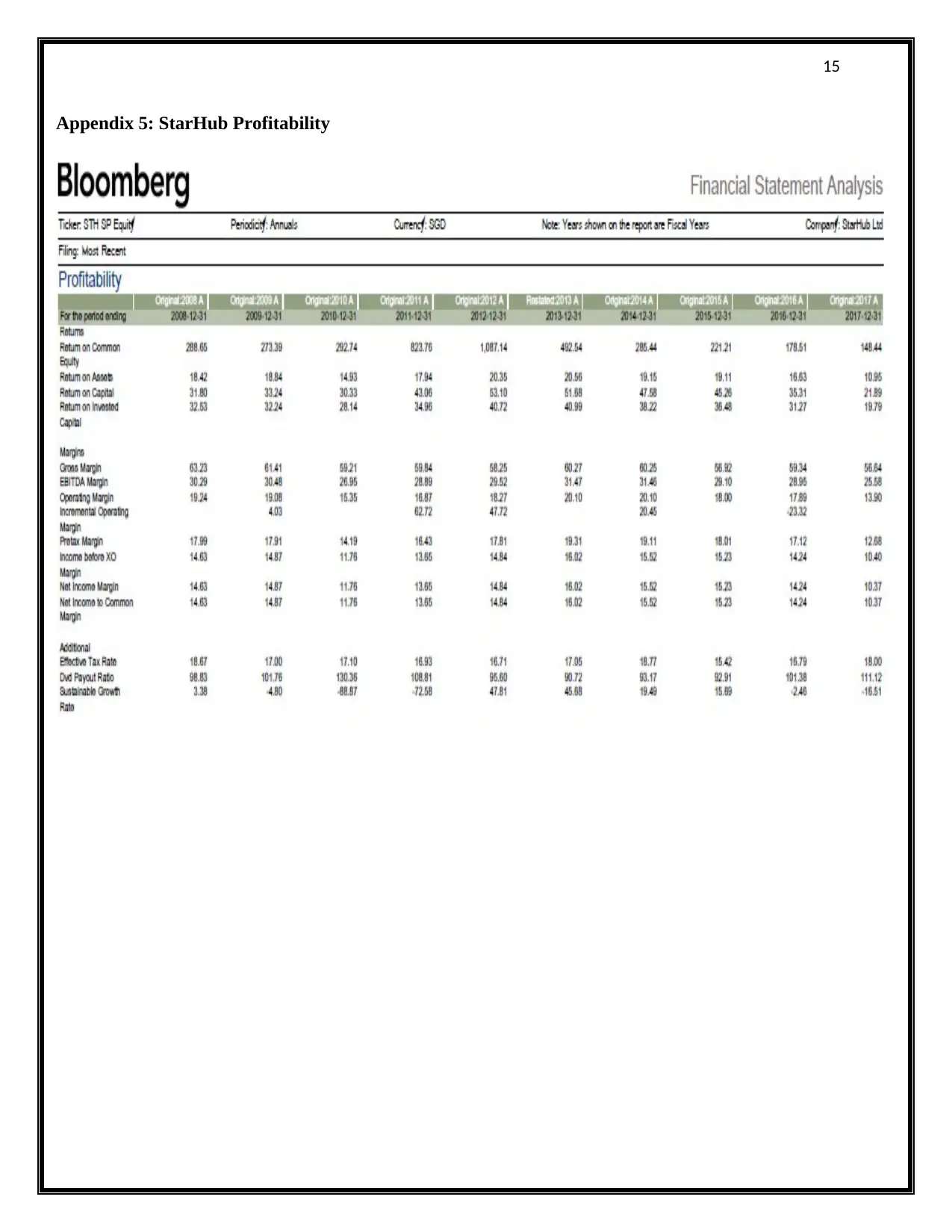
15
Appendix 5: StarHub Profitability
Appendix 5: StarHub Profitability
⊘ This is a preview!⊘
Do you want full access?
Subscribe today to unlock all pages.

Trusted by 1+ million students worldwide
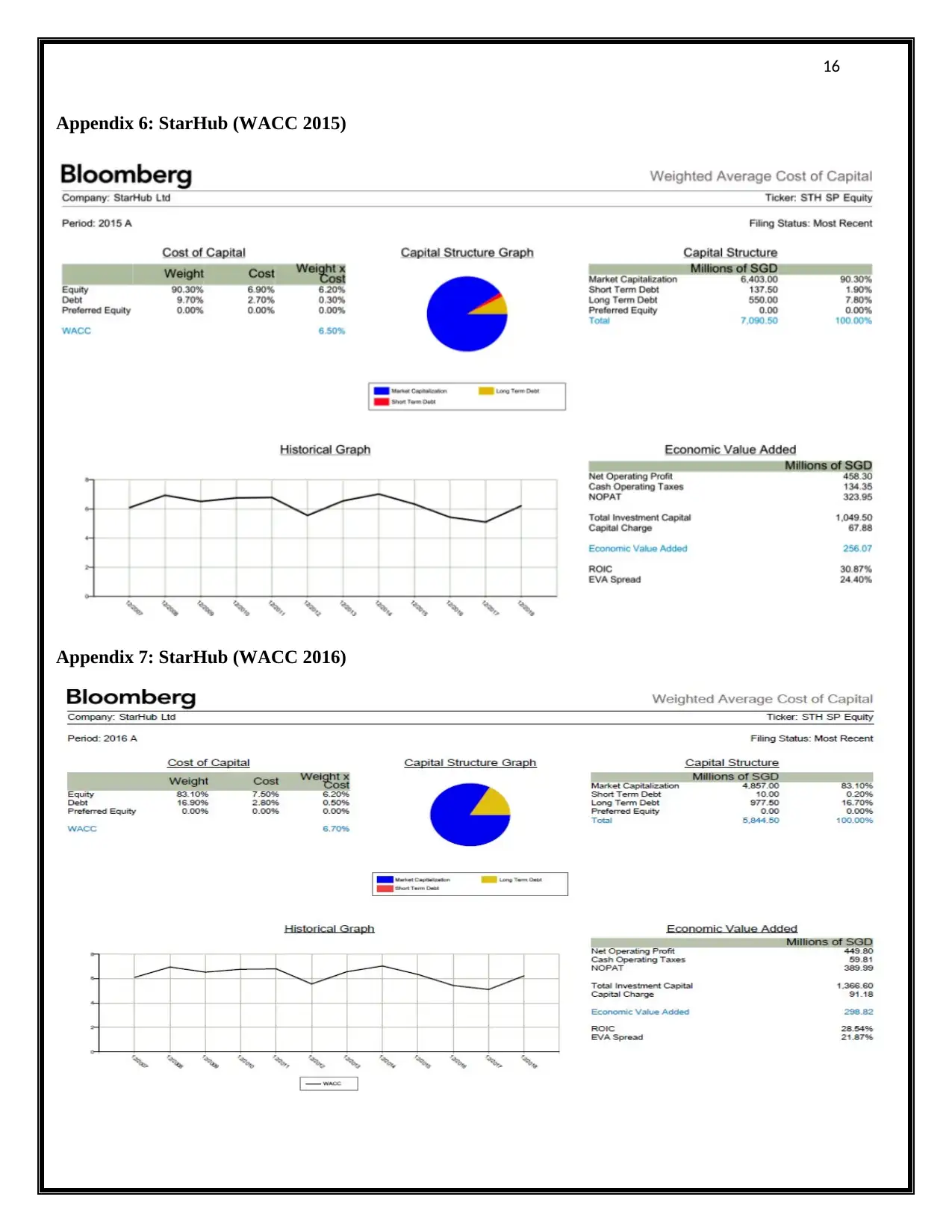
16
Appendix 6: StarHub (WACC 2015)
Appendix 7: StarHub (WACC 2016)
Appendix 6: StarHub (WACC 2015)
Appendix 7: StarHub (WACC 2016)
Paraphrase This Document
Need a fresh take? Get an instant paraphrase of this document with our AI Paraphraser
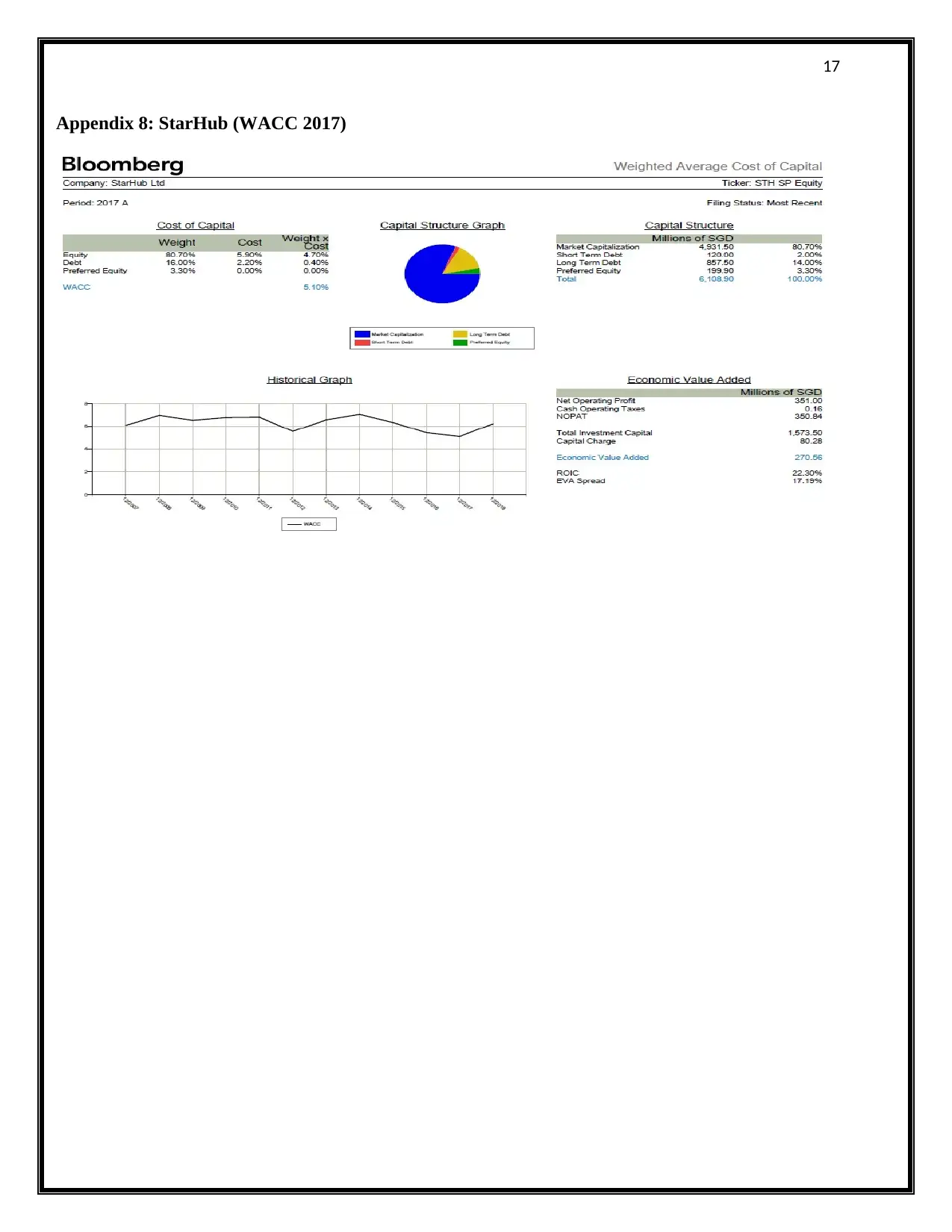
17
Appendix 8: StarHub (WACC 2017)
Appendix 8: StarHub (WACC 2017)
1 out of 17
Related Documents
Your All-in-One AI-Powered Toolkit for Academic Success.
+13062052269
info@desklib.com
Available 24*7 on WhatsApp / Email
![[object Object]](/_next/static/media/star-bottom.7253800d.svg)
Unlock your academic potential
© 2024 | Zucol Services PVT LTD | All rights reserved.





